
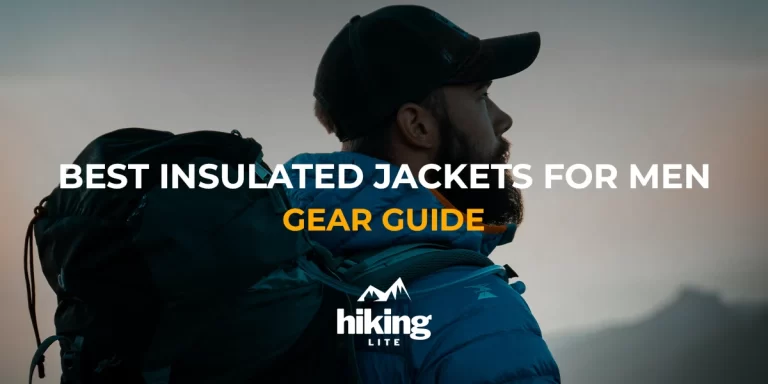
When it comes to exploring the great outdoors, having the right gear can make all the difference, especially when it comes to staying warm and comfortable.
One essential piece of gear for any outdoor adventure is a good insulated jacket. These jackets are designed to keep you warm in cold weather without weighing you down with extra bulk.
In this guide, we’ll take a look at some of the best insulated jackets for men, from trusted brands to innovative new designs.
Let’s get started.
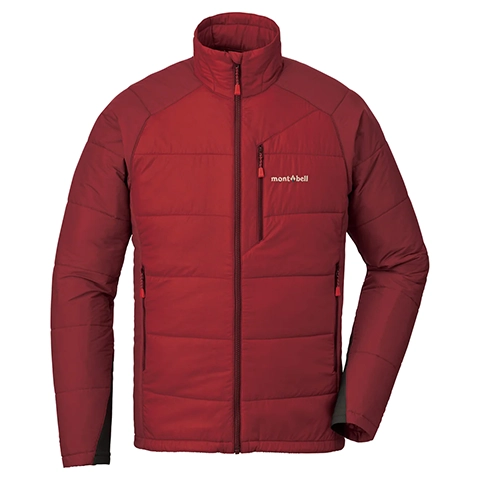
Key Specs
Weight: 8.5 ounces (241 grams)
Material: 12D nylon
Price: $$$
PROS
✅ Ultralight
✅ Comfortable
CONS
❌ Not the warmest option
The Montbell UL Thermawrap ultralight hiking jacket is designed for active outdoor pursuits in cool weather. Engineered with advanced synthetic insulation, it offers remarkable stretch, breathability, and quick-drying properties. This jacket is built to enhance your trail experience by reducing the need for layer shedding, allowing you to focus on your adventure.
It’s important to note that while the UL Thermawrap is incredibly lightweight, it may not provide the same level of warmth as some other insulated jackets. If you prioritize mobility and versatility in your outdoor gear, this jacket could be a valuable addition to your kit.
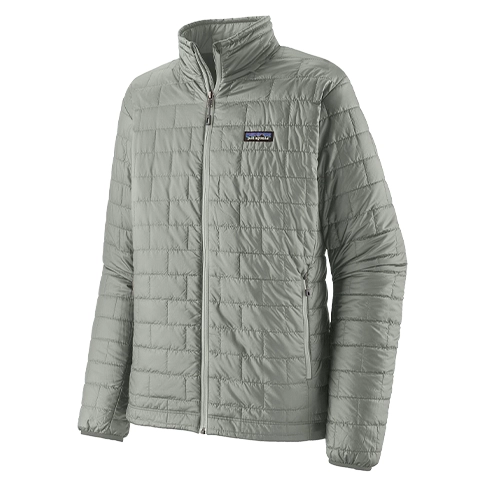
Key Specs
Weight: 11.88 ounces (337 grams)
Material: 20D polyester
Price: $$$
PROS
✅ Warm
✅ Good for light rain
CONS
❌ Might run small for some
The Patagonia Nano Puff® Jacket is a warm and versatile ultralight hiking jacket. Its incredibly lightweight design features 60-g PrimaLoft Gold Insulation Eco, made from 100% postconsumer recycled polyester. The jacket’s 100% recycled polyester shell and lining contribute to its eco-friendly construction.
With a focus on sustainability, the jacket also offers practical features like zippered pockets, a center-front zipper with storm flap, and a drawcord-adjustable drop-tail hem for sealing in warmth.
We appreciate its warmth-to-weight ratio, water resistance, and environmentally conscious materials.
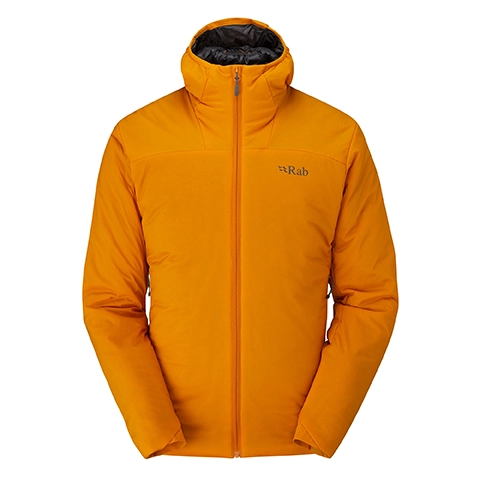
Key Specs
Weight: 10.76 ounces (305 grams)
Material: 20D nylon
Price: $$
PROS
✅ Good fit
✅ Breathable
CONS
❌ Not suitable for mountaineering
The Rab Xenair Alpine Light Hoody stands out as a versatile and lightweight ultralight hiking jacket. Its adaptability makes it well-suited for stop-and-start situations, positioning it as an excellent choice.
Thanks to a strategic insulation map, it ensures an effective balance of temperature throughout the body. Moreover, practical attributes like articulated sleeves, adjustable cuffs and hem, and zip pockets bolster its functionality.
One noteworthy aspect is that the hood is relatively compact, making it suitable for regular hikes, but it may not accommodate a larger helmet.
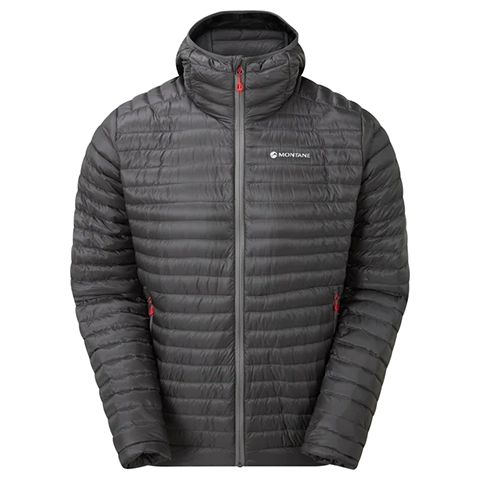
Key Specs
Weight: 11.64 ounces (330 grams)
Material: 10D nylon
Price: $$$
PROS
✅ Great quality
✅ Comfortable
CONS
❌ Slightly baggy fit
The Montane Anti-Freeze Lite hooded down jacket is a top choice for lightweight insulation during fast-paced adventures. This jacket provides warmth and convenient stowage in its own stuff sack.
Crafted with recycled materials and responsibly sourced down, it serves as a versatile layering option. With 750+ fill power water-resistant down, it effectively balances warmth and packability.
While the fit may be slightly baggy, the overall quality remains high. For lightweight warmth without compromising performance, this jacket is an excellent choice.

Key Specs
Weight: 10.2 ounces (290 grams)
Material: 15D polyamide
Price: $
PROS
✅ Affordable
✅ Breathable
CONS
❌ Not good in rain
The Forclaz Men’s MT100 Hooded Down Jacket shines as an ethically sourced and warm choice. Its lightweight and highly compressible design enables you to conserve backpack space for lighter journeys.
The compact design effortlessly folds into its own pocket, while the water-repellent outer fabric effectively guards against moisture. Although not entirely waterproof, it deserves commendation for its remarkable warmth and breathability.
It is a solid budget option.
Picking the right jacket is crucial for comfort and safety when getting ready for a hiking trip.
Insulation Layer: This middle layer should trap body heat yet allow breathability.
Popular Options: Down is extremely compressible and warm for its weight but loses effectiveness when wet. Synthetics aren’t as lightweight but perform well when wet.
Fabric: Breathable fabrics like ripstop nylon, softshells or fleece prevent moisture buildup. Water-resistant options offer extra protection from precip in rough conditions.
Ventilation: Look for features like underarm zips, adjustable hem cords or other venting to prevent overheating on uphills. Full-zips allow easy on/off access.
Fit: Layering requires flexible mobility. Prioritize a trim cut that isn’t constricting but seals out drafts at cuffs and hem with adjustable closures.
Adaptability: Additional features like hoods, handwarmer pockets and high collars enhance usability and comfort in varying temperatures.
Durability: Reinforced fabrics, seams and stress points extend the jacket’s lifetime through rugged use over time.
Choosing an insulated jacket with these key factors will keep you cozy on the trail for many trips to come. For a detailed guide on selecting the right hiking jacket, check out our post here.
When selecting an insulated jacket, choose a durable, stylish option with technical fabrics and features suited to your activity, like windproofing for hiking. Prioritize warmth from insulation layers, breathable and water-resistant materials, ventilation zips to prevent overheating, a mobility-focused fit that seals out drafts, and design details like hoods and hand pockets that adapt to varying conditions, so you stay comfortable and protected through rugged use.
To determine if a jacket has sufficient insulation for cold conditions, check the fill power and fill weight of down or the weight and thickness of synthetic insulation. Higher fill power down and heavier synthetic insulation provide more warmth. Also look for features like snug cuffs, drawcord hems, high collars, and chin guards that seal in body heat. Finally, consider the external fabric’s wind and water resistance. Quality insulation coupled with weather-blocking outer fabric ensures a jacket can retain warmth in frigid temps.
Layer clothing by wearing moisture-wicking base layers closest to skin, then a warm insulating mid layer like an insulated jacket, and finally a weatherproof outer shell. The baselayer wicks away sweat, the insulated jacket traps body heat, and the waterproof outer layer blocks wind and rain. Use breathable fabrics to vent excess moisture and heat. Make sure layers aren’t too tight or restrictive. Shed or add layers as conditions change. Following these layering principles with an insulated jacket at the core ensures you stay dry, warm and comfortable in cold weather.